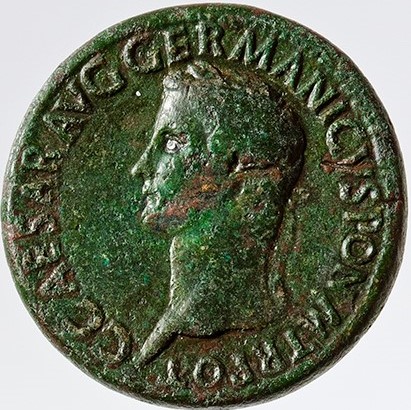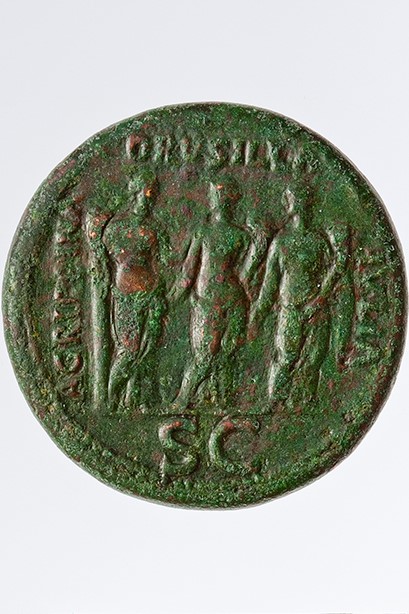Acquisition number: 1974.05
Obv.: Bust of Gaius l., laureate. C(aius) CAESAR AVG(ustus) GERMANICVS PON(tifex) M(aximus) TR(ibunicia) POT(estate).
Rev.: Gaius’ three sisters (named in the legend) standing front, draped, each holding cornucopiae; hair knotted at back. AGRIPPINA DRVSILLA IVLIA. In exergue, S(enatus) C(onsulto).
Title: Sestertius of Gaius (Caligula) - 1974.05
Acquisition number: 1974.05
Author or editor: Beryl Rawson
Culture or period: Roman Imperial
Date: AD 37-38
Material: Metal - Brass
Object type: Coins - Roman
Dimensions: 32mm (w)
Origin region or location: Italy
Origin city: Rome
Display case or on loan: 5
Keywords: Coin, sestertius, Roman, Imperial, Caligula
Mattingly, H., E.A. Sydenham, C.H. Sutherland, R.A. Carson, The Roman Imperial Coinage 13 vols (London, Spink, 1923-1994) 33; Sear, D.R., Roman Coins and their Values 5 vols (London, Spink, 2000-2014) 1800; Mattingly, H.,Coins of the Roman Empire in the British Museum, 6 vols (London, 1965) 36; Giard, J.-P., Catalogue des Monnaies de l’Empire Romain 3 vols (Paris: Bibliothèque Nationale, 1988-1998) 47, [Rome, AD 37-8].
Breglia, L., Roman Imperial Coins: Their Art and Technique (New York, F.A. Praeger, 1968) 44-45 (incl. pll.);. Giacosa, G., Ritratti di Auguste (Milan, Arte e Moneta, 1974) 30-31 and pl. X; Grant (1954) ch. 281.
Sutherland, C.H.V., Roman Coins (London, Putnam, 1974) 153 and pl. 281.
1974.05
Sestertius of Gaius (Caligula)
25.591 g. AD 37-38
Obv.: Bust of Gaius l., laureate. C(aius) CAESAR AVG(ustus) GERMANICVS PON(tifex) M(aximus) TR(ibunicia) POT(estate).
Rev.: Gaius’ three sisters (named in the legend) standing front, draped, each holding cornucopiae; hair knotted at back. AGRIPPINA DRVSILLA IVLIA. In exergue, S(enatus) C(onsulto).
Gaius (Caligula) and his sisters were the children of Agrippina the Elder (granddaughter of Augustus) and Germanicus (grandson of Livia). Germanicus’ father Drusus (see 67.05) had earned the title Germanicus for his German military successes under Augustus and the title became hereditary in his family. Gaius inherited the names C. (Iulius) Caesar from his father, who, although born a Claudian, was adopted by Tiberius in AD 4 as part of a ‘package deal’ whereby Augustus adopted Tiberius into the Julian family. The title of Pontifex Maximus (head priest) was now normally bestowed on a new emperor, as was tribunician power (if he did not already it).
The coin portraits of Gaius are of high artistic standard. The obverse head is of bolder relief than were those of Tiberius, and there are finely composed reverse. Breglia points out the ‘three-dimensional, architectural’ aspects of the reverse.
The attributes of the three sisters (Agrippina resting right arm on column, Drusilla holding a sacrificial dish, the patera, in right hand, and Julia holding rudder in right hand) suggest that the women were to be identified with the personifications of Salus-Securitas (Well-being), Concordia (Harmony), and Fortuna (Fortune).
Previously, women’s heads had rarely appeared on Roman coins, and it was a new departure for the coins to explicitly name a living woman. (See Grant ch. IX.) Gaius’ mother (see 68.26) had already died and his grandmother Antonia died soon after his accession in AD 37. Gaius was married only briefly between his accession and his marriage to Lollia Paulina in the latter part of AD 38. His sisters were the closest surviving members of his family, and they shared fully in the honours which he devised for his family. They were given the status of Vestal Virgins, their names were included in the oath of loyalty to the emperor, and their figures and names appeared on coins. When Drusilla died in the middle of AD 38 she was deified (the first Roman woman to be so honoured), but she did not appear on the coins as DIVA. Presumably Roman convention baulked at that. However, Claudius deified his grandmother Livia soon after his accession in AD 41 and put DIVA AVGVSTA on coins commemorating her. Gaius’ other sisters probably did not appear further on coins, and in AD 39 they were sent into exile after an alleged conspiracy on Gaius’ life.
Under Gaius the concept of an ‘imperial family’ strengthened, and Agrippina the Younger’s experiences in the early years of Gaius’ reign must have sharpened her expectations when she returned to Rome in AD 41 and later became Claudius’ wife. The women of the Julio-Claudian families were especially important as the inheritors of the blood of Augustus, and this was the basis of much of their status, ambition and intrigue. Agrippina was the only one of Gaius’ sisters to bear a son (Nero).
Gaius’ taste for exceptional honours may be connected with family tradition in that his great-grandfather was Mark Antony, who adapted with great ease to the customs of Hellenistic monarchies, especially that of Cleopatra in Egypt.
Mattingly, H., E.A. Sydenham, C.H. Sutherland, R.A. Carson, The Roman Imperial Coinage 13 vols (London, Spink, 1923-1994) 33; Sear, D.R., Roman Coins and their Values 5 vols (London, Spink, 2000-2014) 1800; Mattingly, H.,Coins of the Roman Empire in the British Museum, 6 vols (London, 1965) 36; Giard, J.-P., Catalogue des Monnaies de l’Empire Romain 3 vols (Paris: Bibliothèque Nationale, 1988-1998) 47, [Rome, AD 37-8].
Breglia, L., Roman Imperial Coins: Their Art and Technique (New York, F.A. Praeger, 1968) 44-45 (incl. pll.);. Giacosa, G., Ritratti di Auguste (Milan, Arte e Moneta, 1974) 30-31 and pl. X; Grant (1954) ch. 281.
Sutherland, C.H.V., Roman Coins (London, Putnam, 1974) 153 and pl. 281.
IX. Sutherland (1974) 153 and pl. 281.

